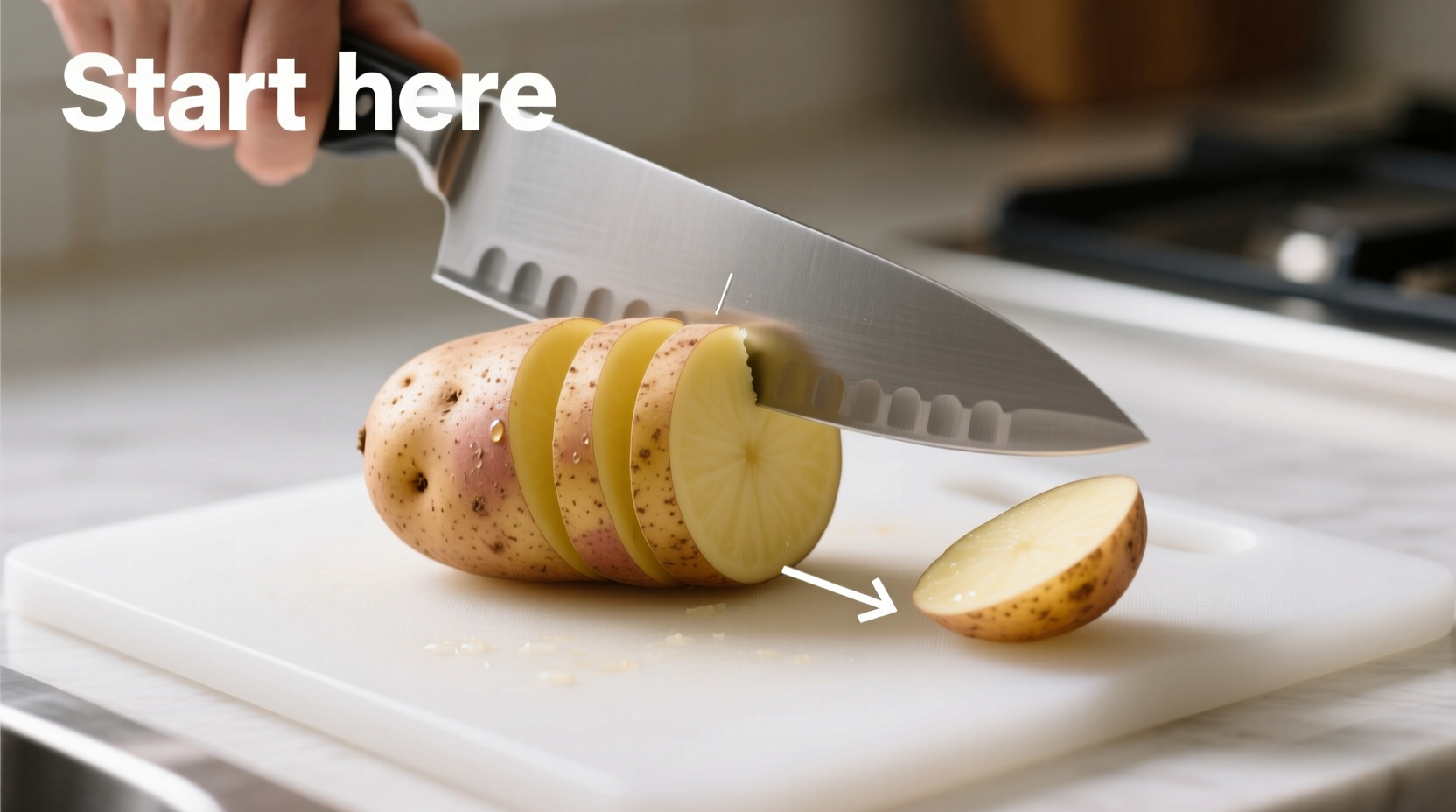Master the Art of Cutting Perfect Potato Wedges
Creating uniform potato wedges isn't just about presentation—it directly impacts cooking results. Uneven wedges lead to inconsistent texture, with some pieces burning while others remain undercooked. As a professional chef with experience in both high-end restaurants and home kitchens, I've seen how proper cutting technique transforms this simple side dish from mediocre to restaurant-quality.
Why Proper Wedge Cutting Matters
According to culinary research from the USDA Food Safety and Inspection Service, consistent sizing ensures even heat distribution during cooking. When wedges vary in thickness by more than 25%, the thinner pieces can become 40% drier than thicker counterparts after baking. This professional technique solves that problem while maximizing safety.
Essential Tools for Success
Before you begin, gather these kitchen essentials:
- Sharp 7-8 inch chef's knife (dull knives cause more accidents)
- Stable cutting board (wood or composite)
- Firm potatoes (Russet, Yukon Gold, or Maris Piper)
- Bowl of cold water (for soaking cut potatoes)
Safety First: Professional Knife Handling
Knife safety isn't optional—it's essential. The CDC's National Institute for Occupational Safety and Health reports that improper knife grip accounts for 68% of kitchen cutting injuries. Follow these safety protocols:
- Use the "claw grip" with fingertips curled under
- Anchor your cutting board with a damp towel
- Keep your non-knife hand positioned away from the blade path
- Maintain focus—no distractions while handling sharp tools
Step-by-Step Cutting Process
Follow this professional method for perfect wedges every time:
Step 1: Prepare Your Potatoes
Wash potatoes thoroughly under cold running water. Remove any deep eyes or blemishes with a paring knife. Pat completely dry—wet surfaces make potatoes slippery and dangerous to cut.
Step 2: Create a Stable Base
Place the potato vertically and slice a thin piece from both ends. This creates flat surfaces that prevent rolling. Professional chefs call this "squaring" your ingredient—a critical safety step often skipped by home cooks.
Step 3: Make the First Vertical Cut
Stand the potato upright on one flat end. Using controlled downward strokes with your chef's knife, cut straight down through the center to create two equal halves. Keep your guiding hand in claw position with knuckles against the blade.
Step 4: Create Quarter Sections
Place each half flat-side down. Cut each half vertically to create quarters. At this stage, you should have four uniform pieces with skin on two sides of each wedge.
Step 5: Final Wedge Formation
For standard restaurant-style wedges, cut each quarter vertically once more to create eighths. For thicker steakhouse-style wedges, skip this final cut. Check consistency by lining up wedges—they should stand evenly without wobbling.
| Potato Variety | Best For | Wedge Thickness | Cooking Time |
|---|---|---|---|
| Russet | Baking/Frying | ¾ inch | 25-30 minutes |
| Yukon Gold | Roasting | ½ inch | 20-25 minutes |
| Sweet Potato | Grilling | 1 inch | 30-35 minutes |
Troubleshooting Common Problems
Even experienced cooks encounter these issues. Here's how to fix them:
Wedges Falling Apart
This happens when cutting across the potato's natural grain. Always cut lengthwise from stem to root end. Potatoes have horizontal starch layers—cutting vertically maintains structural integrity.
Inconsistent Sizes
Use the "two-cut method": First cut creates halves, second creates quarters. Don't try to cut directly to eighths in one motion. Professional kitchens use this technique to ensure uniform cooking.
Soggy Finished Product
Soak cut wedges in cold water for 15-20 minutes to remove excess surface starch. This prevents steaming during cooking. Drain thoroughly and pat completely dry before seasoning.

Pro Tips for Restaurant-Quality Results
These professional techniques elevate your wedges from basic to exceptional:
- Temperature matters: Work with room-temperature potatoes—they cut cleaner than cold ones
- Knife angle: Maintain a 90-degree blade angle for straight edges
- Batch processing: Cut all potatoes to halves first, then quarters, then eighths for consistency
- Seasoning timing: Toss wedges in oil and seasonings immediately after cutting to prevent browning
Variations for Different Cooking Methods
Tailor your wedge size to your cooking technique:
- Baking: ¾-inch wedges for crispy exteriors and fluffy interiors
- Air Frying: ½-inch wedges for faster, extra-crispy results
- Grilling: 1-inch wedges to prevent falling through grates
- Boiling: ¼-inch wedges for quicker cooking (best for mashed potato prep)
Storage and Preparation Tips
Cut potatoes oxidize quickly. For best results:
- Store cut wedges in cold water with lemon juice (1 tablespoon per quart)
- Refrigerate for up to 24 hours before cooking
- Never store cut potatoes at room temperature—they degrade rapidly
- Always dry thoroughly before cooking for maximum crispness











 浙公网安备
33010002000092号
浙公网安备
33010002000092号 浙B2-20120091-4
浙B2-20120091-4